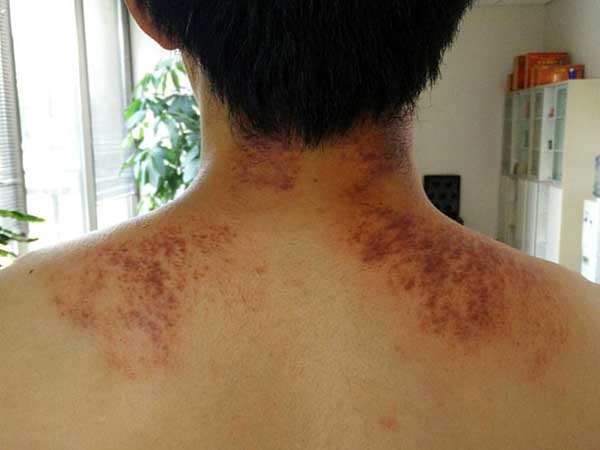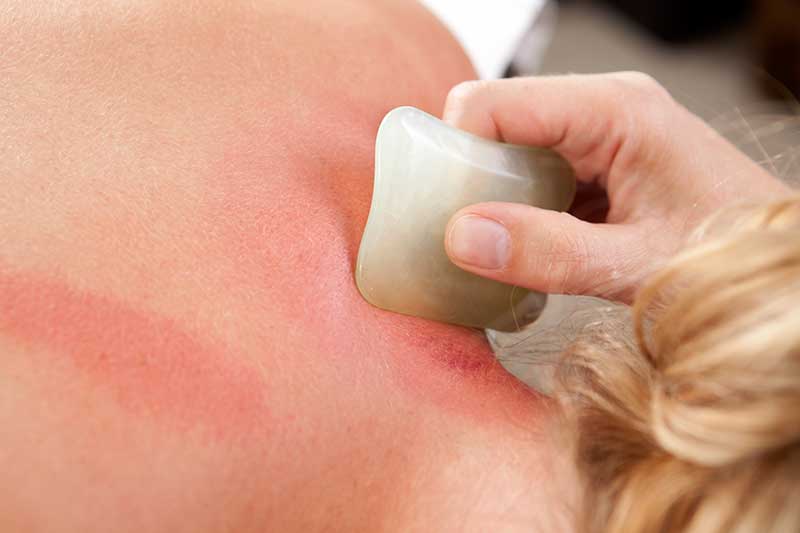The Gua Sha technique is quickly making a name for itself. Many spas and beauty salons are now offering clients access to this technique. The Gua Sha technique helps to stimulate blood flow and the lymphatic system. There are several potential benefits that a person may gain when they opt for a Gua Sha massage. One particular thing that people do need to take note of is the Gua Sha color chart.
At first, the color chart may seem a little confusing. A thorough understanding of this particular element, first described in traditional Chinese medicine references, is important. This will help you understand what the specific markings mean that tend to develop once you have gone through a Gua Sha session.

The Petechiae Of Gua Sha
When looking at a color chart for the Gua Sha technique, some people do not know exactly what this term refers to. This is why it is important that we first consider the term petechiae – as this has a direct reference to the Gua Sha color chart that is often described as part of this traditional Chinese therapeutic technique.
A petechial essentially refers to spots that develop on the skin. The term petechiae are often used in association with Gua Sha because many people who undergo this therapy will experience more than just one petechial.
The presence of petechiae on the skin can mean various things. Sometimes, they are considered harmless. In other cases, however, the presence of petechiae may be a sign of something more serious in the patient’s body.
In the majority of cases, petechiae will appear in specific areas of a person’s body. The affected body parts will often include:
- Arms
- Legs
- Stomach
- Buttocks
Other areas of the skin can be affected too.
You might be asking what the connection between Gua Sha and petechiae is now. When a person undergoes a Gua Sha session, they will often find that following the procedure; they develop petechiae on the treated area of their body.
This is generally due to the specific way that the Gua Sha scraping tool works on the skin. It helps to boost circulation and has other effects that may ultimately lead to the development of petechiae.
With Gua Sha, the petechiae would only be temporary. A person would find that they appear shortly following the procedure and then start to fade rather quickly.
Chinese practitioners who focus on alternative and more traditional therapies will often use these petechiae to identify possible health problems in a person’s body. The color that the petechiae presents itself in can tell the Chinese medicine practitioner a lot about the general health of the client’s body.
What Does The Gua Sha Color Chart Mean?
Depending on the area where a Gua Sha massage is performed, the practitioner may wait for the development of petechiae to give the patient a view on their general health. These spots on the skin will only be present for two or three days, after which they will fade. While they are present, a Chinese traditional practitioner can determine if the person who received the massage may suffer from certain health ailments.
The Gua Sha color chart refers to the meaning of different colors in which the petechiae may present itself.
Below is an overview of colors that petechiae may be presented in – along with the meaning of each color:
- Pink: A typical pink color is rather common. It means that the area where the petechiae developed may suffer from a blood deficiency. Additionally, a typical pink petechial also means that the illness the person suffers from had only developed very recently.
- Dark Red: When there is a deep dark red color present in the petechiae that develop, then it will generally be considered a sign of inflammation. The specific area surrounding the area where the Gua Sha technique was performed will be affected by inflammation. A dark red color may also signal inflammation in other areas of the person’s body. It is also important to note that a deep dark red color generally means that the stagnation – or the condition and underlying disease – is busy building up. This is usually considered a sign of an underlying condition that may be developing.
- Purple or Black: Petechiae that presents in either a black or a purple color, is said to have the same meanings. The two tend to signal the presence of a long-term condition that has already developed in the person’s body. In some cases, black or purple petechiae may also be a sign of underlying tissue damage.
- Brown: When the petechiae that develop possess a brown color, then it is generally thought to signal dehydration. This means the person is not consuming enough fluids and may be suffering from the complications of dehydration.
When the petechiae that develop after a Gua Sha session does not fade within the first three days, then it may be a sign that the individual has poor blood circulation. Regardless of the color, in such a condition, it may take the petechiae up to one week or longer to completely fade.

Conclusion
Gua Sha may cause a person to experience the development of small spots on their skin. These spots are referred to as petechiae and they are not considered harmful. Petechiae are not a sign of skin-related damage caused by the Gua Sha technique either. Instead, they develop due to the mechanism of action behind the Gua Sha massage technique. Traditional Chinese practitioners tend to use the color of the petechiae that develop after a Gua Sha session to determine if a person may be suffering from certain health conditions. This is where the Gua Sha color chart comes into play.
Related Reading
References
https://www.healthline.com/health/petechiae

Try our Anti-Aging Gua Sha Tool designed to bring out your skin’s natural glow.
Best Gua Sha Product- Anti-Aging: The tool is designed to target 11 specific aging signs such as wrinkles and sagging skin. By following the 7-step routine, users can improve skin firmness and reduce fine lines naturally.
- Enhances Skincare Routine: It works effectively with serums and lotions, boosting absorption and efficacy of skincare products.
- Visible Skin Improvement: Users can expect a smoother complexion, reduced puffiness, and a more youthful appearance.
 P. Sze
P. Sze 

















